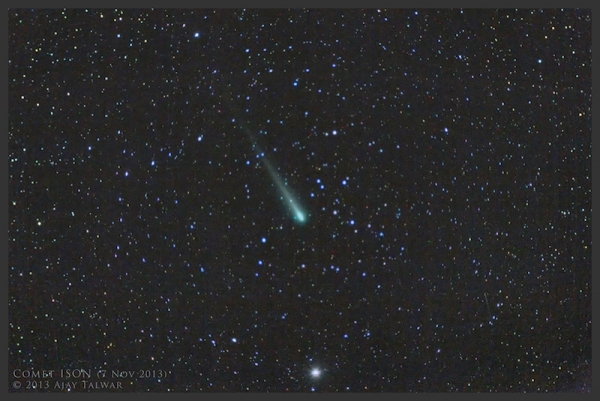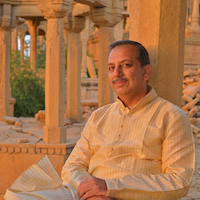by Ajay Talwar
- Published: Saturday, April 05 2014 07:33
Comet ISON was discovered by Vitali Nevski & Artyom Novichonok in September 2012, when it was at a distance of 6au from Sun. Soon after discovery it was detected in some pre-discovery images too. Astronomers calculated the orbit of this new discovery and found that:
- It was a new comet coming from the outer reaches of the Solar System, the Oort Cloud.
- Discovered at such a great distance the comet was intrinsically bright.
- ISON would become a Sungrazer comet, passing very close to fiery atmosphere of the Sun later near its perihelion.
Pretty soon the comet was catapulted to a glorious status all over the world. In a matter of weeks it was being touted to be the “Comet of the Century” by the attention seeking media (just in the 13th year of the century). Astronomers were sceptical about the euphoria and rightfully so. The comet would be a good study nevertheless.
 Comet ISON. Photo by Ajay Talwar
Comet ISON. Photo by Ajay Talwar
In April 2013, when ISON was about 4au from Sun, I was quite surprised to receive an invitation to attend a Consultation Workshop on ISON Comet, to be held at the Homi Bhabha Centre for Science Education, Mumbai (HBCSE). The convenor organisations of the workshop were All India Peoples Science Network (AISPN), HBCSE, Vigyan Prasar, and Navnirmiti. At the consultation workshop I met about two dozen persons from various institutes and individuals from all over India, professional astrophysicists, amateur astronomers, science educators, science educators, science popularisers, communication designers and artists. It was quite a diverse gathering. We deliberated for two days and a night.
In the meeting, it was decided that the arrival of the Comet ISON provided a very good opportunity to launch a massive campaign. The excitement in tracking the comet, and the opportunity it provides for several science activities by children in the learning-by-doing mode, as well as the long-term potential of such an effort to develop an interest in them in watching objects in the night-sky. The apparition of ISON could well become a vehicle on which science could be taken to the far flung corners of India.
It was decided to produce resource material in printed and digital forms that would be publicly available on a web portal, and plan a cascading series of training workshops for resource persons, in order to reach a large number of children nation-wide in each district. It was also decided to form a co-ordination committee, and constitute an advisory panel.
India is a large country, and with an even larger population. Slowly the numbers involved sank in my mind. The amount of effort needed to reach the number of children in each district of India would be astronomical. Thankfully, I was given the relatively easy task of technical support.
The campaign was christened “EYES on ISON”. We had seven months before ISON would reach its perihelion at the end of November 2013.
The road map for these seven months was completed at the consultation workshop. It was emphasised that the content of the campaign should be relevant even after the comet had come and gone. The activities like watching the sky should become a routine for children reached by the campaign.
The campaign took off with the dedicated efforts of the initial diverse bunch of people who had met at Mumbai. There was no promise of remuneration or rewards. Looking at the intense efforts, funds were promised from various governmental sources.
ISON was about 2.3au away from the Sun, in August 2013, when the three National Workshops were conducted at Bengaluru, Guwahati and Bhopal in quick succession. Six to seven resource persons from each state of India attended. 220 resource persons were trained and provided with media, experiments, kits, parodies of Bollywood songs and ability to overcome obstacles, handle mass media and even how to generate funds in their own states for conducting state level workshops. The resource persons took a pledge to take the campaign forward. The campaign was taking shape.
 Comet ISON in Tijara. Photo by: Ajay Talwar
Comet ISON in Tijara. Photo by: Ajay Talwar
As ISON travelled closer to Sun at great speed, the state level workshop were held one after the other. The resource persons soon multiplied in these state workshops. These next level resource persons promised that they would go to their districts and conduct at least 2-3 activities (out of a dozen) in at least ten schools in their district. The activity could be hands on experiments, poster exhibition, lecture, and evening observation with a telescope and others. The state level workshop organisers demanded resource material in their state language, they were steadily provided with all resource material in soft form translated in their own language by the core group. A central resource in the form of a website worked well. The workshops could download the relevant material and news from the campaign website.
As ISON crossed the orbit of Earth in its journey towards the Sun, the campaign went ahead to many schools in most of the 593 districts of India, with hands on experiments, movies, night observations, poster exhibitions etc.
As ISON crossed the orbit of Mercury just days before its fiery encounter with the Sun, many Eyes were expectedly looking for ISON in the dawn hours all over the country. They hoped to catch the sight of the ‘Puchaltara’ (star with a tail).
The comet failed our expectations, when it vaporised behind the Sun, but EYES on ISON campaign did not fail to arouse the curiosity in the children of India towards astronomy and the night sky.
The archives, all resource material and the information about the campaign can be found at the campaign website: www.eyesoncometison.in
###
 Ajay Talwar, TWAN photographer from India hopes to photograph the many natural and historical wonders in India at night under the stars.
Ajay Talwar, TWAN photographer from India hopes to photograph the many natural and historical wonders in India at night under the stars.
During his school days, Ajay Talwar was always working on some science projects. He had built a simple telescope with a cardboard and lenses bought at the flea market. During college days in 1985-86, comet Halley was visible in the skies. Ajay visited a place called Ganga Sagar about a hundred kilometres from Calcutta and saw the comet very nicely from that remote place. His interest in astronomy was ignited on that trip. Ajay took up astrophotography because it was difficult and not many people were pursuing it. It was taken as a challenge, astrophotography used to be quite difficult with film cameras. With the advent of digital cameras astrophotography became easy, primarily because the results are instantaneous and one could correct a mistake right away. In the film days correcting a mistake was a process which took a month or two!
Recently his TWAN style work was exhibited at a pan India festival of photography in public spaces called “Fete de la Photo” organised by the French Cultural Institute in India. The exhibition ran in eight cities across India.
Sky Photo Trip – is the name of the astrophotography workshop that he conducts in the Himalayas regularly. The 6th Sky Photo Trip has been held in Himalayas on 21-23 March 2014. Ajay lives at Gurgaon a suburb of New Delhi, but his heart lives in the Himalayas where stars shine brightly, from Nanda Devi to the zenith.








Comments